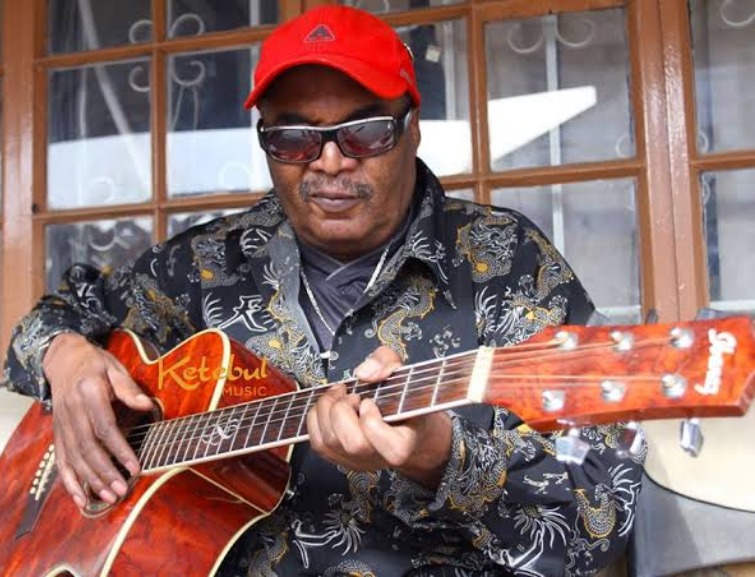Other band members were not as lucky. They began dying. Ten are in Lang’ata cemetery, 1000 kilometres from home
By Undercover Reporter
He cried easily when asked about the former band members of Super Mazembe.
Kasongo wa Kanema, was among the last crew standing, his recent death, marking an end to Congolese musicians who immigrated to Kenya over 40 years ago, seeking fame and fortune.
Most found fleeting fame, rarely fortune. Kasongo, somewhat, found both before the music stopped at 73; complications from hypertension, appendicitis, stroke.
He lived in Lang’ata, the estate, not far from the cemetery where he will join more than 10 members of the original Super Mazembe, the band that gave us Shauri Yako, Samba and Kasongo-their most famous song.
Kasongo, contrary to popular belief, was not in Kanema’s honour, rather, Super Mazembe had a predilection for naming songs after band members. Kosongo was named after its rhythm guitarist, Kasongo Songoley just as Kayembe was in honour of Kayembe Rapok and Samba was after Samba Mapangala, the guest soloist in the song, Shida, but who founded his own Orchestre Virunga.
Funny how Congolese bands had orchestra on their names, yet they had no orchestras in the true meaning of an orchestra with violins, oboes, cellos, trombones, clarinets, bassoons, horns.
Although the most famous face of Super Mazembe, Kasongo wa Kanema, was not among original members
The closest they went was having trumpets and sometimes saxophones, but anyway, the orchestra in question was founded by Longwa Didos in 1967 as Super Vox, before later changing its name to Orchestra Super Mazembe, ‘Mazembe’ meaning ‘bulldozers.’
It shunned copying popular Lingala styles of Franco Makiadi and Tabu Ley, and instead veered to its own style, compositions in lilting Swahili peculiar to Kisangani Province in Zaire, now the DRC.
Although he became the most famous face of Super Mazembe, Jean-Claude Kasongo wa Kanema, was not among original members.
When it was founded, Kasongo was hewing sand in mines where death was so imminent when they collapsed, he decided his fortunes lay in guitars and his vocals.
Zaire was then under the iron grip of President Mobutu Seseseko and as Howard French notes in Anatomy of an Autocracy, Zaireans “endured 31 years of a stupid, vicious dictatorship while cooking up the best music and tastiest caterpillars on the continent.”
Learning instruments from church music paid off for Kasongo who sought musical fortunes in Tanzania, playing with Orchestra Marquis, enroute to Kenya where Super Mazembe had come from Zambia and pitched tent in 1974, the year 80 percent of Kenyan MPs were sent home by angry voters.
Super Mazembe came under the invitation of Zambian music producer and owner of Nairobi’s Eagles band, Nashil Pichen Kazembe-famous for the Twist song, Pole Musa, a collabo with Peter Tsotsi.
Kasongo joined four years later as a rhythm guitarist and soloist who also composed among others, Izabela for Super Mazembe.
That decade saw a gradual decline in American Soul. Congolese rhumba took over night clubs in Nairobi where recording studios churned out quality recording for many Congolese bands including Baba Nationale of Baba Gaston, Les Kenois, Les Mapengelepa and Super Mazembe, then playing at Halians Club along Nairobi’s Tom Mboya street, before shifting to Club Madunis, later more famous as New Florida Night Club (Mad House) on Koinange street.
Super Mazembe recorded and performed, life was good. A single record of Shauri Yako sold 250, 000 copies as fans got carried away by not only Mazembe’s Moshosho dance style, but also what music critic Trevor Herman called songs that sparkled with “passionate vocals, razor sharp guitar licks, monumental bass lines, thrilling horns and a rhythm that demands your attention.”
Soukous, from the French word ‘secouer’ means to ‘shake’ and boy! didn’t Kenyans shake to Soukous
That was until the collapse of EMI Records and then A.I.T Records saw it disbanding in 1986, along with it, loss of music loyalties as distribution rights changed hands for as little as Sh50, 000.
Kasongo later retreated to his own Watoto Studios at Yaya Centre in between live performances.
Other band members were not as lucky. They began dying, just as new bands and Congolese styles were emerging away from Mazembe’s spare, easy listening and slow Moshosho dancing style.
Soukous featuring syncopated rhythms and intricate contrasting guitar melodies was the in-thing. Soukous, from the French word ‘secouer’ means to ‘shake’ and boy! didn’t Kenyans shake to Soukous styles like Kwasa Kwasa- where the hips move back and forth with the hands following suit. Kwasa Kwasa was made famous by Pepe Kalle and Kanda Bongo Man before the Ndombolo dancing craze of 1997, appealing to the rough at the edges, mostly the bottom drawers.
New styles and fresh faced musicians pushed the likes of Super Mazembe to the periphery
Musicians Awilo Longomba, Aurlus Mabele and Wenge Musica popularized the fast paced hip-swinging dance which the government tried banning without success.
Ndombolo, though, was a mockery of the late President Laurent Kabila’s funny looking pot belly inside a Kaunda suit as Michela Wrong informs us in her 2001 book, In the Footsteps of Mr Kutz: Living on the Brink of Disaster in Mobutu’s Congo.
The dance crazes, she writes “are not without a sense of political and social irony. Ndombolo was invented by street kids of Kinshasa and “involves spreading the legs apart, bending the knees and poking one’s bottom in the air,” notes Wrong, adding that “the Ndombolo combines a crude imitation of sex with mocking mimicry of the gait of the overweight Laurent Kabila.”
Another version of Ndombolo involved limping as Kabila had ‘limped’ into Kinshasa after overthrowing President Mobutu!
The death of Kasongo wa Kanema is an epitaph to a golden age of Congolese rhumba
These new styles including Koffi Olomide’s Tcha-cho dance, and fresh faced musicians pushed the likes of Mangelepa, Orchestra Virunga and Super Mazembe to the periphery.
While their music remained nostalgically popular, dwindling royalties and performing to few old school music buffs saw most Congolese musicians living 100 metres below the poverty line: Vivi Kalenga composer of Embakasi with Mangelepa holed up in a single room in Dandora Phase II-where the late Moreno Batamba operated a butchery in the 1980s while Longwa Didos, founder of Super Mazembe performed in clubs along Mlolongo on Mombasa Road before his death.
Of Lang’ata cemetery, Congolese musicians say “hapo ndio kwetu” and its home to Baba Gaston, Lovy Longomba and Moreno Batamba and other Super Mazembe members: Atia Jo, Dodo Doris, Kasongo Songoley, Longwa Didos, Bukalos wa Bukasa and Katele Kilambe Alley-the composer of majority of their hits like Kasongo.
The death of Kasongo wa Kanema is an epitaph to a golden age of Congolese rhumba and the transient fragility of music as a source of livelihood thousands of kilometers away from home.

